Analyzing the Effects of Oral Language on Reading Comprehension
VerifiedAdded on 2022/11/09
|5
|961
|417
Homework Assignment
AI Summary
This paper explores the critical role of oral language in the development of reading comprehension, written expression, and decoding skills. It begins by defining oral language and its fundamental link to literacy. The paper then delves into the impact of oral language on decoding, reading comprehension, and written expression, drawing on research to illustrate these connections. It presents two communication strategies designed to improve reading skills, such as generating questions from passages and utilizing context clues. Additionally, the paper outlines strategies to enhance written expression, including the use of restriction and topic-control techniques. Finally, it highlights the role of assistive technologies, such as text-to-speech tools and graphical organizers, in supporting reading and writing development. The paper concludes that a combination of traditional and technological support can effectively assist individuals in improving their literacy skills.
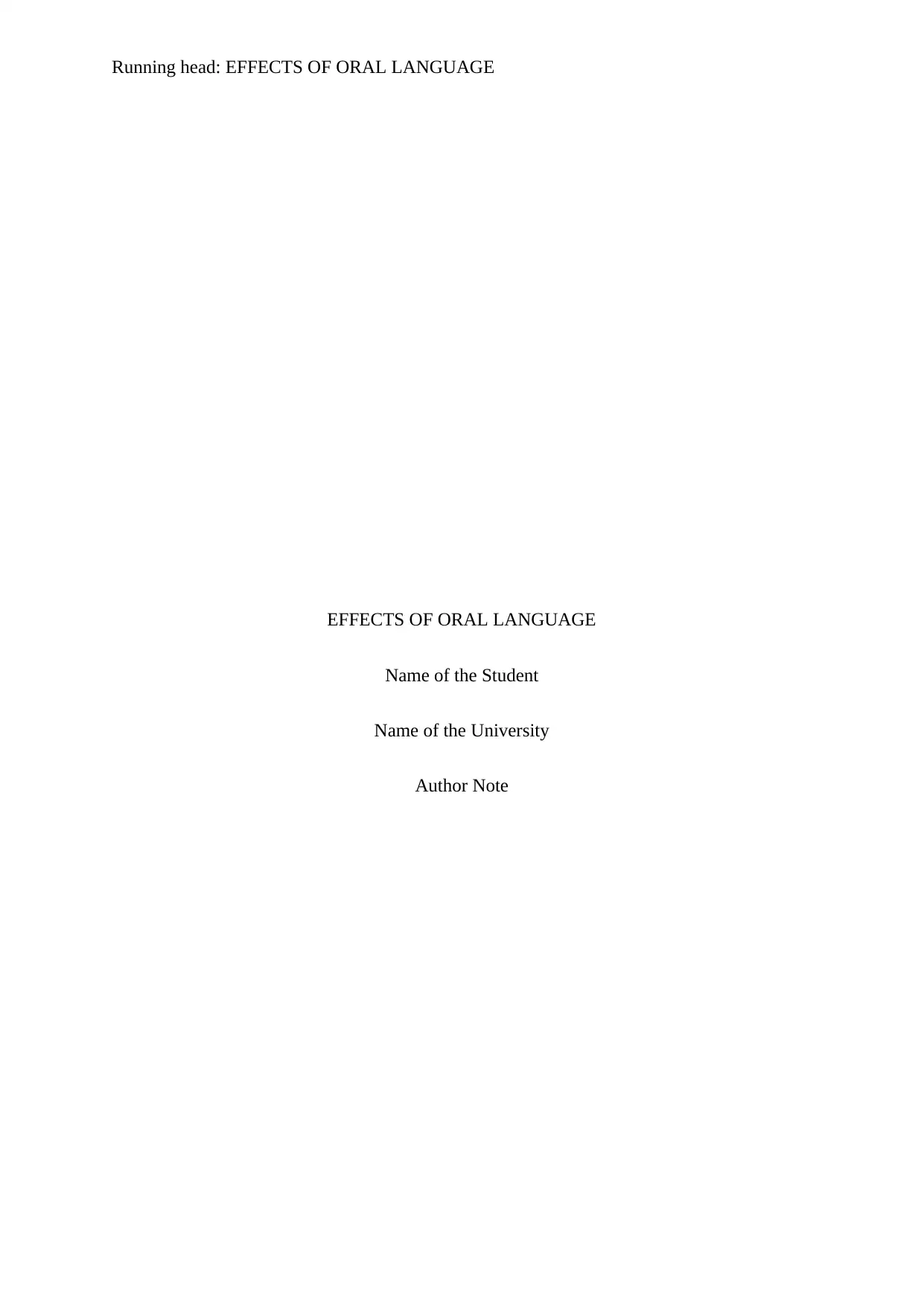
Running head: EFFECTS OF ORAL LANGUAGE
EFFECTS OF ORAL LANGUAGE
Name of the Student
Name of the University
Author Note
EFFECTS OF ORAL LANGUAGE
Name of the Student
Name of the University
Author Note
Paraphrase This Document
Need a fresh take? Get an instant paraphrase of this document with our AI Paraphraser
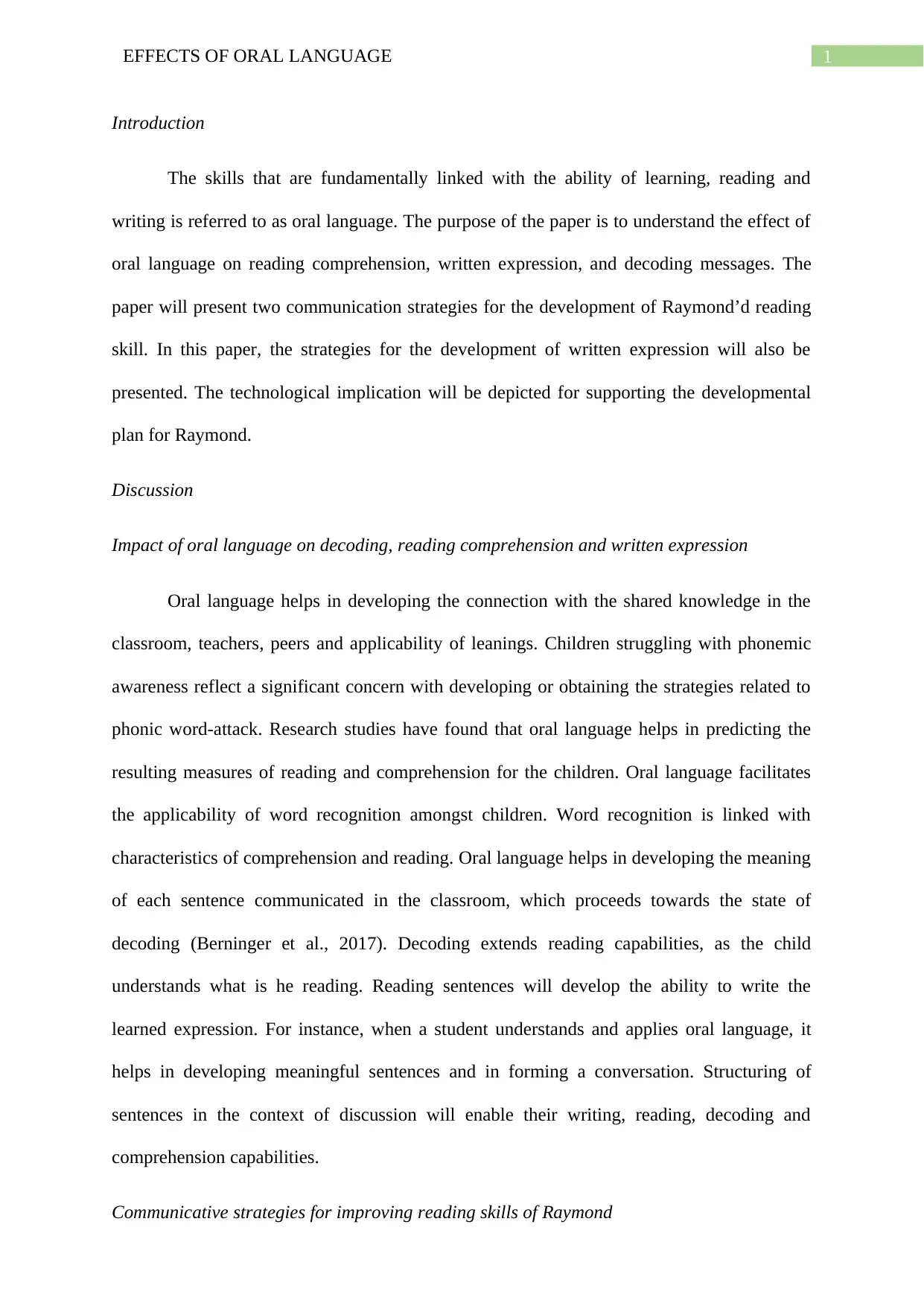
1EFFECTS OF ORAL LANGUAGE
Introduction
The skills that are fundamentally linked with the ability of learning, reading and
writing is referred to as oral language. The purpose of the paper is to understand the effect of
oral language on reading comprehension, written expression, and decoding messages. The
paper will present two communication strategies for the development of Raymond’d reading
skill. In this paper, the strategies for the development of written expression will also be
presented. The technological implication will be depicted for supporting the developmental
plan for Raymond.
Discussion
Impact of oral language on decoding, reading comprehension and written expression
Oral language helps in developing the connection with the shared knowledge in the
classroom, teachers, peers and applicability of leanings. Children struggling with phonemic
awareness reflect a significant concern with developing or obtaining the strategies related to
phonic word-attack. Research studies have found that oral language helps in predicting the
resulting measures of reading and comprehension for the children. Oral language facilitates
the applicability of word recognition amongst children. Word recognition is linked with
characteristics of comprehension and reading. Oral language helps in developing the meaning
of each sentence communicated in the classroom, which proceeds towards the state of
decoding (Berninger et al., 2017). Decoding extends reading capabilities, as the child
understands what is he reading. Reading sentences will develop the ability to write the
learned expression. For instance, when a student understands and applies oral language, it
helps in developing meaningful sentences and in forming a conversation. Structuring of
sentences in the context of discussion will enable their writing, reading, decoding and
comprehension capabilities.
Communicative strategies for improving reading skills of Raymond
Introduction
The skills that are fundamentally linked with the ability of learning, reading and
writing is referred to as oral language. The purpose of the paper is to understand the effect of
oral language on reading comprehension, written expression, and decoding messages. The
paper will present two communication strategies for the development of Raymond’d reading
skill. In this paper, the strategies for the development of written expression will also be
presented. The technological implication will be depicted for supporting the developmental
plan for Raymond.
Discussion
Impact of oral language on decoding, reading comprehension and written expression
Oral language helps in developing the connection with the shared knowledge in the
classroom, teachers, peers and applicability of leanings. Children struggling with phonemic
awareness reflect a significant concern with developing or obtaining the strategies related to
phonic word-attack. Research studies have found that oral language helps in predicting the
resulting measures of reading and comprehension for the children. Oral language facilitates
the applicability of word recognition amongst children. Word recognition is linked with
characteristics of comprehension and reading. Oral language helps in developing the meaning
of each sentence communicated in the classroom, which proceeds towards the state of
decoding (Berninger et al., 2017). Decoding extends reading capabilities, as the child
understands what is he reading. Reading sentences will develop the ability to write the
learned expression. For instance, when a student understands and applies oral language, it
helps in developing meaningful sentences and in forming a conversation. Structuring of
sentences in the context of discussion will enable their writing, reading, decoding and
comprehension capabilities.
Communicative strategies for improving reading skills of Raymond
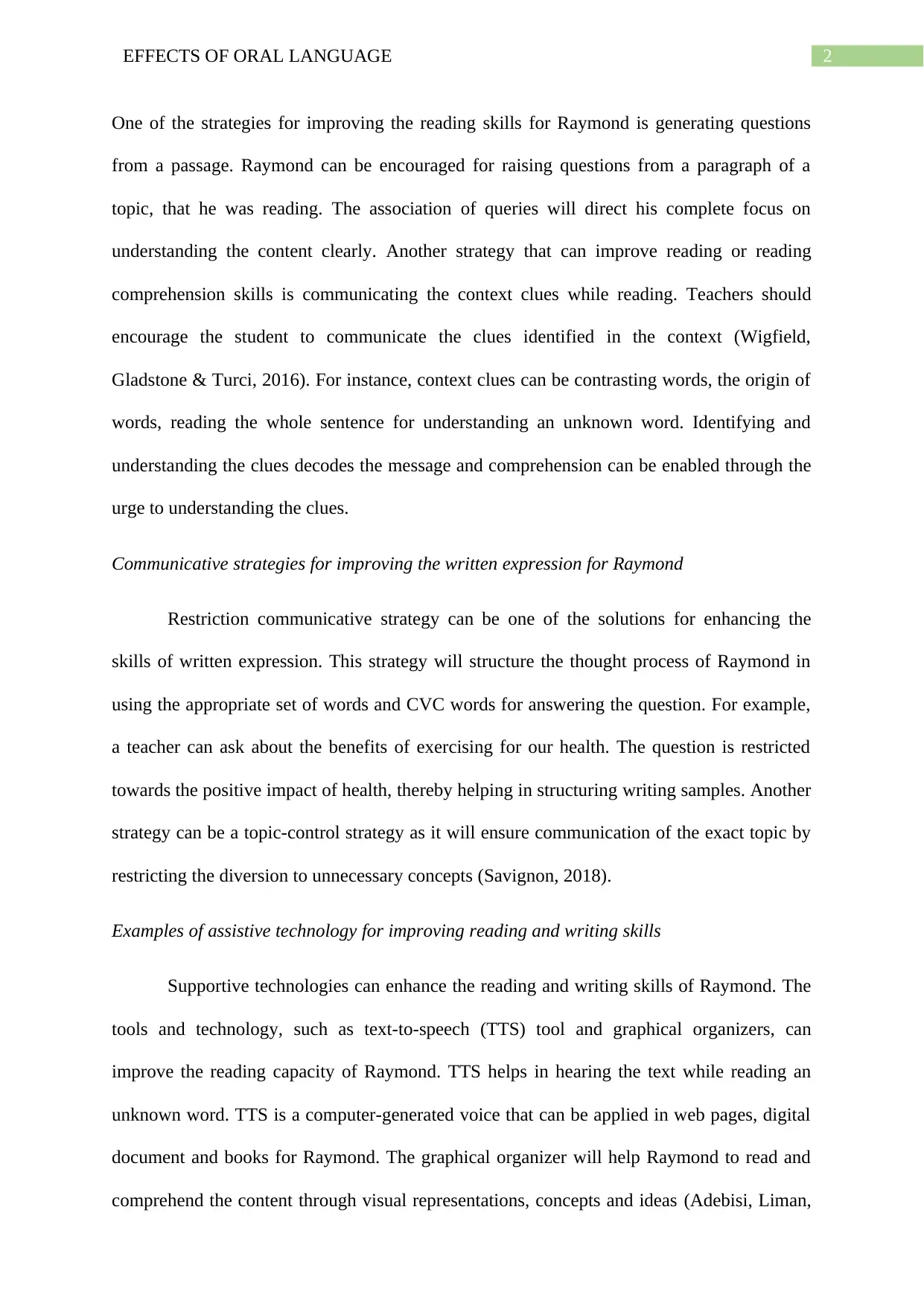
2EFFECTS OF ORAL LANGUAGE
One of the strategies for improving the reading skills for Raymond is generating questions
from a passage. Raymond can be encouraged for raising questions from a paragraph of a
topic, that he was reading. The association of queries will direct his complete focus on
understanding the content clearly. Another strategy that can improve reading or reading
comprehension skills is communicating the context clues while reading. Teachers should
encourage the student to communicate the clues identified in the context (Wigfield,
Gladstone & Turci, 2016). For instance, context clues can be contrasting words, the origin of
words, reading the whole sentence for understanding an unknown word. Identifying and
understanding the clues decodes the message and comprehension can be enabled through the
urge to understanding the clues.
Communicative strategies for improving the written expression for Raymond
Restriction communicative strategy can be one of the solutions for enhancing the
skills of written expression. This strategy will structure the thought process of Raymond in
using the appropriate set of words and CVC words for answering the question. For example,
a teacher can ask about the benefits of exercising for our health. The question is restricted
towards the positive impact of health, thereby helping in structuring writing samples. Another
strategy can be a topic-control strategy as it will ensure communication of the exact topic by
restricting the diversion to unnecessary concepts (Savignon, 2018).
Examples of assistive technology for improving reading and writing skills
Supportive technologies can enhance the reading and writing skills of Raymond. The
tools and technology, such as text-to-speech (TTS) tool and graphical organizers, can
improve the reading capacity of Raymond. TTS helps in hearing the text while reading an
unknown word. TTS is a computer-generated voice that can be applied in web pages, digital
document and books for Raymond. The graphical organizer will help Raymond to read and
comprehend the content through visual representations, concepts and ideas (Adebisi, Liman,
One of the strategies for improving the reading skills for Raymond is generating questions
from a passage. Raymond can be encouraged for raising questions from a paragraph of a
topic, that he was reading. The association of queries will direct his complete focus on
understanding the content clearly. Another strategy that can improve reading or reading
comprehension skills is communicating the context clues while reading. Teachers should
encourage the student to communicate the clues identified in the context (Wigfield,
Gladstone & Turci, 2016). For instance, context clues can be contrasting words, the origin of
words, reading the whole sentence for understanding an unknown word. Identifying and
understanding the clues decodes the message and comprehension can be enabled through the
urge to understanding the clues.
Communicative strategies for improving the written expression for Raymond
Restriction communicative strategy can be one of the solutions for enhancing the
skills of written expression. This strategy will structure the thought process of Raymond in
using the appropriate set of words and CVC words for answering the question. For example,
a teacher can ask about the benefits of exercising for our health. The question is restricted
towards the positive impact of health, thereby helping in structuring writing samples. Another
strategy can be a topic-control strategy as it will ensure communication of the exact topic by
restricting the diversion to unnecessary concepts (Savignon, 2018).
Examples of assistive technology for improving reading and writing skills
Supportive technologies can enhance the reading and writing skills of Raymond. The
tools and technology, such as text-to-speech (TTS) tool and graphical organizers, can
improve the reading capacity of Raymond. TTS helps in hearing the text while reading an
unknown word. TTS is a computer-generated voice that can be applied in web pages, digital
document and books for Raymond. The graphical organizer will help Raymond to read and
comprehend the content through visual representations, concepts and ideas (Adebisi, Liman,
⊘ This is a preview!⊘
Do you want full access?
Subscribe today to unlock all pages.

Trusted by 1+ million students worldwide
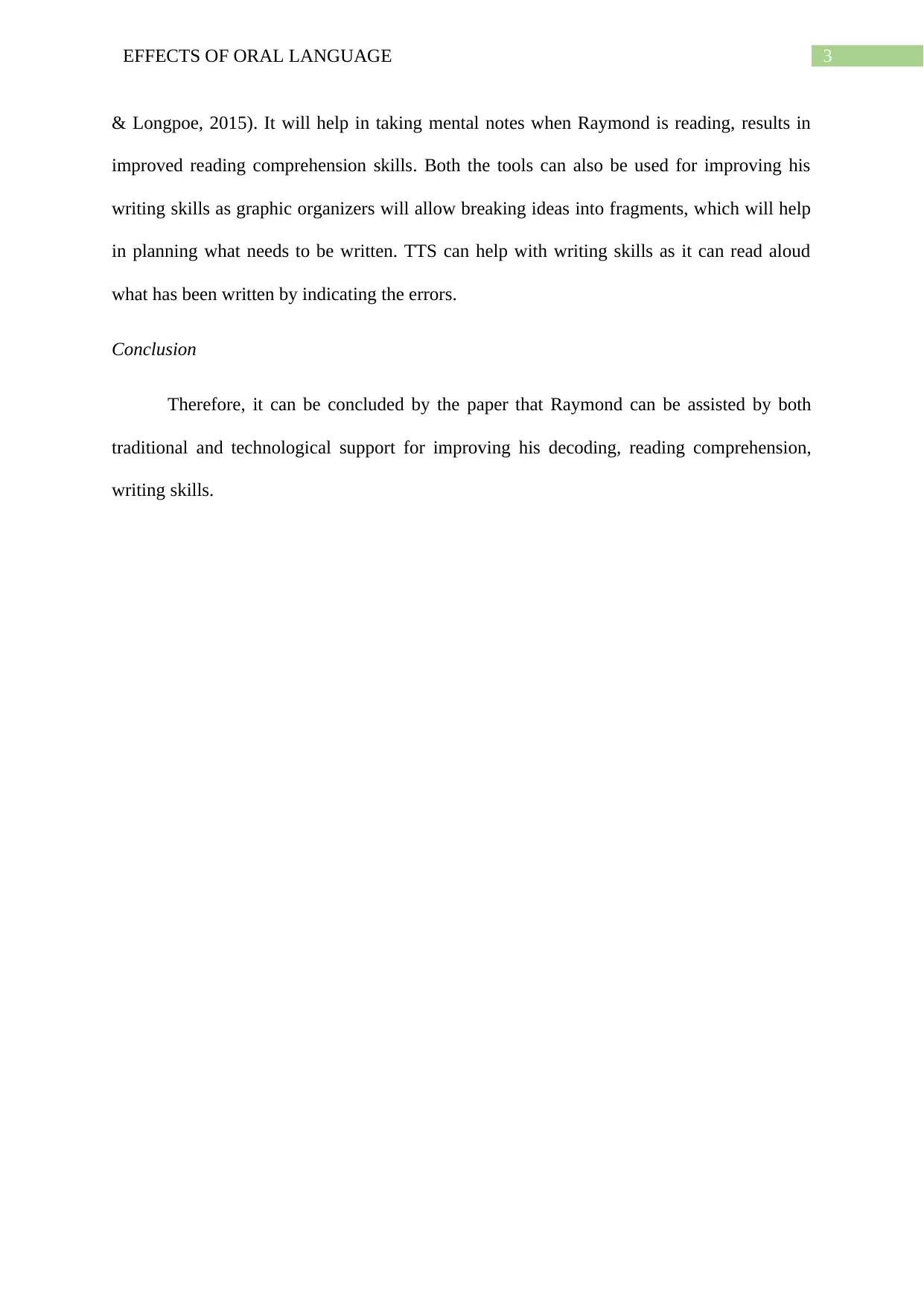
3EFFECTS OF ORAL LANGUAGE
& Longpoe, 2015). It will help in taking mental notes when Raymond is reading, results in
improved reading comprehension skills. Both the tools can also be used for improving his
writing skills as graphic organizers will allow breaking ideas into fragments, which will help
in planning what needs to be written. TTS can help with writing skills as it can read aloud
what has been written by indicating the errors.
Conclusion
Therefore, it can be concluded by the paper that Raymond can be assisted by both
traditional and technological support for improving his decoding, reading comprehension,
writing skills.
& Longpoe, 2015). It will help in taking mental notes when Raymond is reading, results in
improved reading comprehension skills. Both the tools can also be used for improving his
writing skills as graphic organizers will allow breaking ideas into fragments, which will help
in planning what needs to be written. TTS can help with writing skills as it can read aloud
what has been written by indicating the errors.
Conclusion
Therefore, it can be concluded by the paper that Raymond can be assisted by both
traditional and technological support for improving his decoding, reading comprehension,
writing skills.
Paraphrase This Document
Need a fresh take? Get an instant paraphrase of this document with our AI Paraphraser
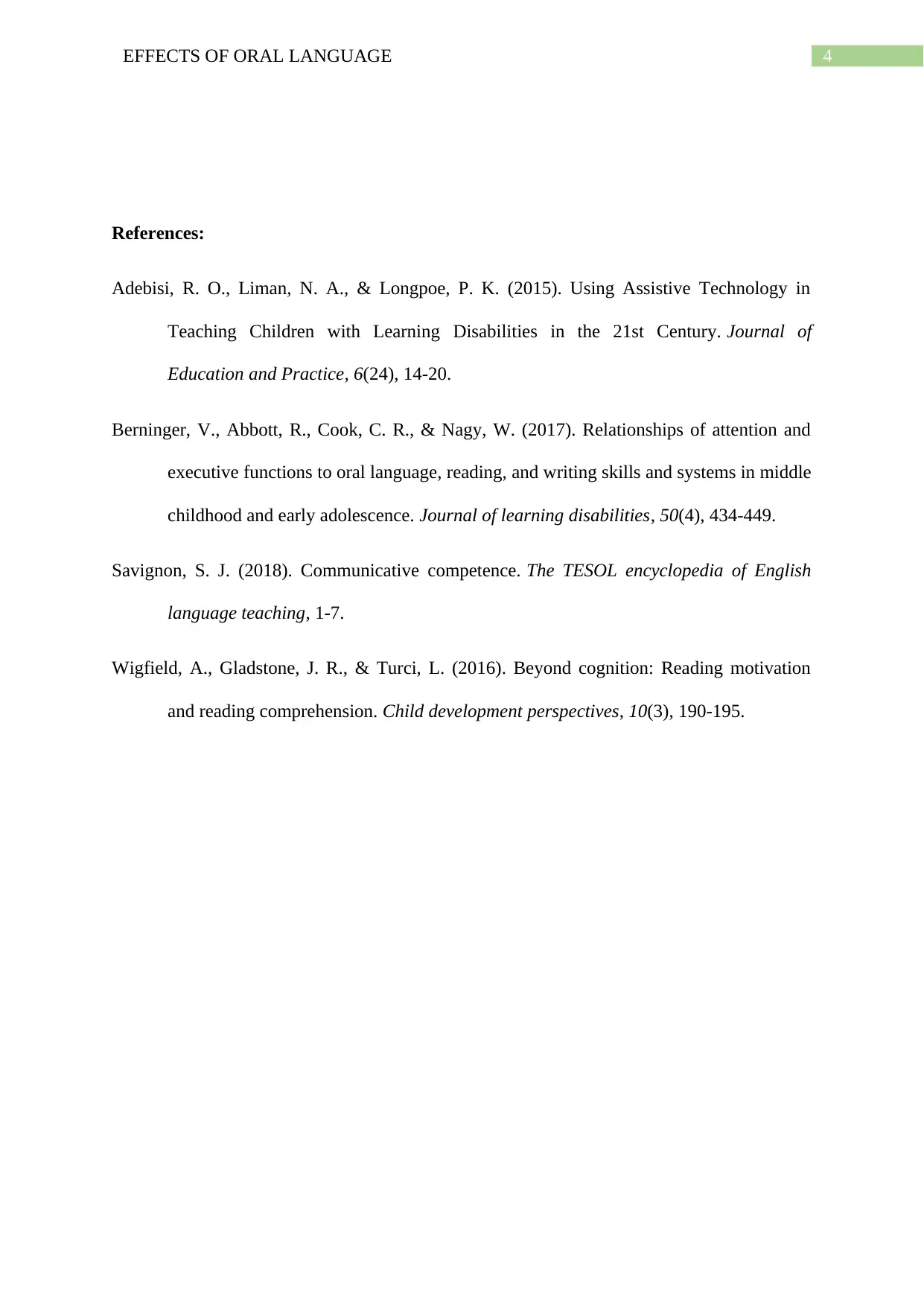
4EFFECTS OF ORAL LANGUAGE
References:
Adebisi, R. O., Liman, N. A., & Longpoe, P. K. (2015). Using Assistive Technology in
Teaching Children with Learning Disabilities in the 21st Century. Journal of
Education and Practice, 6(24), 14-20.
Berninger, V., Abbott, R., Cook, C. R., & Nagy, W. (2017). Relationships of attention and
executive functions to oral language, reading, and writing skills and systems in middle
childhood and early adolescence. Journal of learning disabilities, 50(4), 434-449.
Savignon, S. J. (2018). Communicative competence. The TESOL encyclopedia of English
language teaching, 1-7.
Wigfield, A., Gladstone, J. R., & Turci, L. (2016). Beyond cognition: Reading motivation
and reading comprehension. Child development perspectives, 10(3), 190-195.
References:
Adebisi, R. O., Liman, N. A., & Longpoe, P. K. (2015). Using Assistive Technology in
Teaching Children with Learning Disabilities in the 21st Century. Journal of
Education and Practice, 6(24), 14-20.
Berninger, V., Abbott, R., Cook, C. R., & Nagy, W. (2017). Relationships of attention and
executive functions to oral language, reading, and writing skills and systems in middle
childhood and early adolescence. Journal of learning disabilities, 50(4), 434-449.
Savignon, S. J. (2018). Communicative competence. The TESOL encyclopedia of English
language teaching, 1-7.
Wigfield, A., Gladstone, J. R., & Turci, L. (2016). Beyond cognition: Reading motivation
and reading comprehension. Child development perspectives, 10(3), 190-195.
1 out of 5
Related Documents
Your All-in-One AI-Powered Toolkit for Academic Success.
+13062052269
info@desklib.com
Available 24*7 on WhatsApp / Email
![[object Object]](/_next/static/media/star-bottom.7253800d.svg)
Unlock your academic potential
Copyright © 2020–2025 A2Z Services. All Rights Reserved. Developed and managed by ZUCOL.




